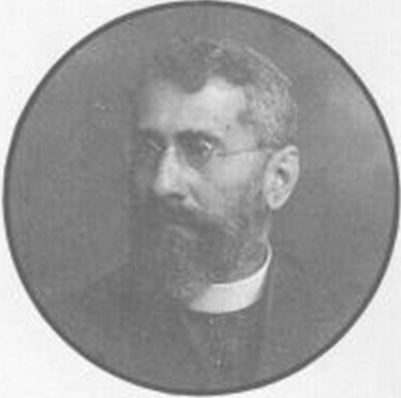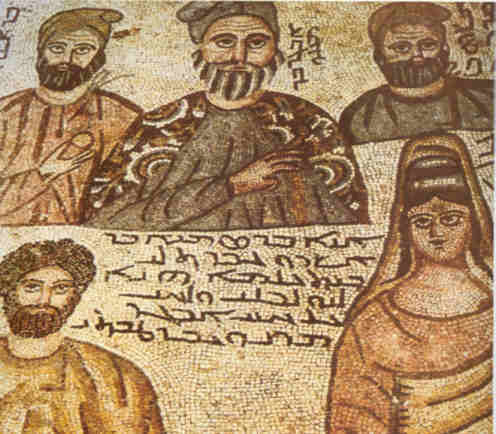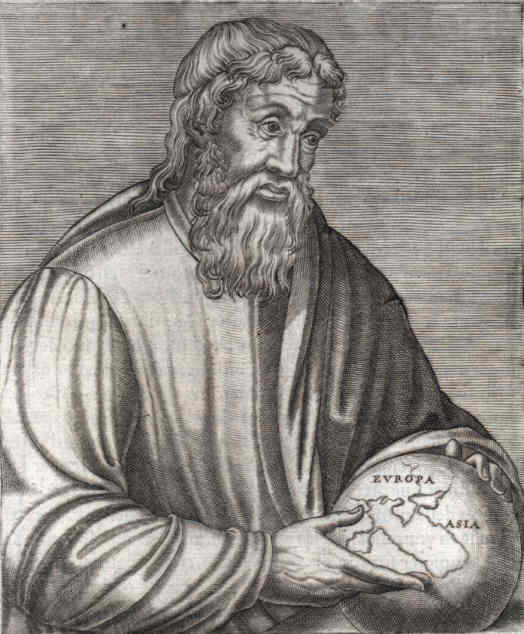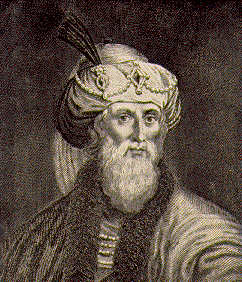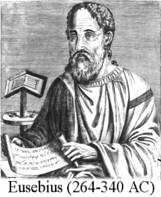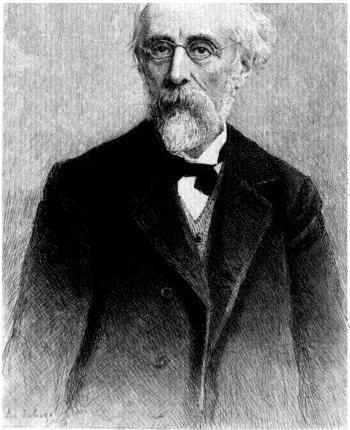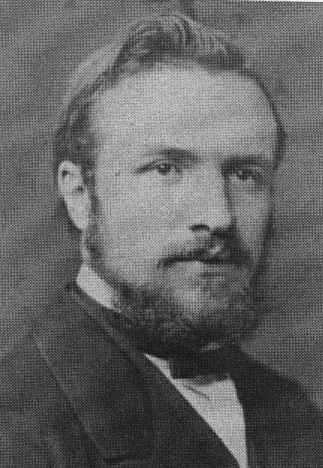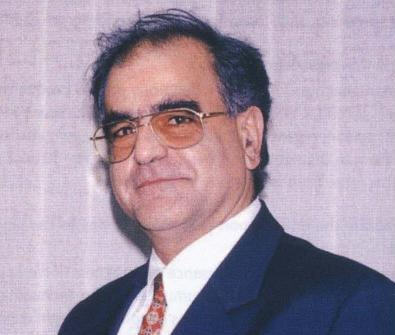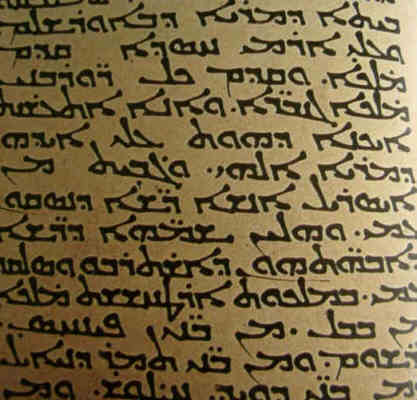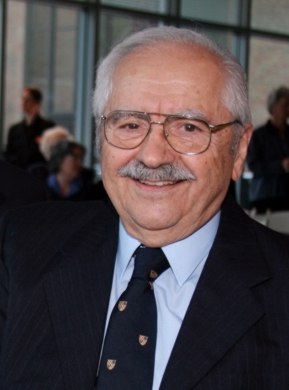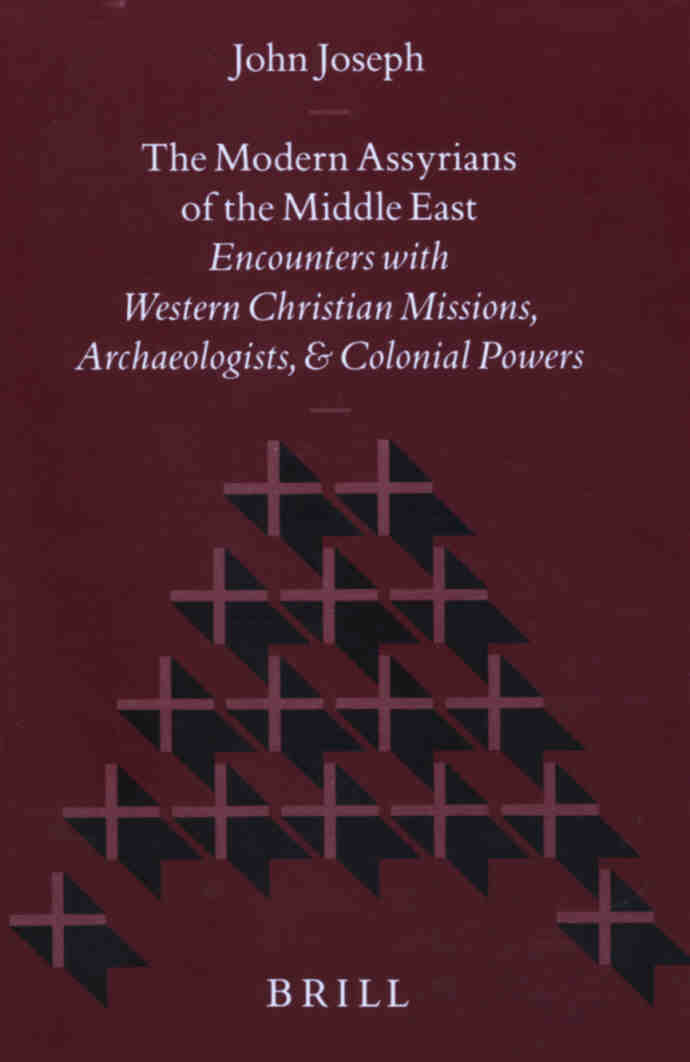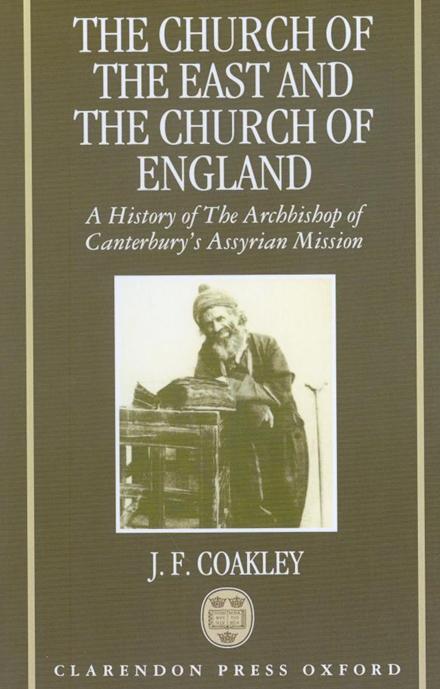|
Jacob Augin Manna
Who made the East- Aramean Nestorians known as "Assyrians"?
SUA/WCA and allowing terrorism
Aramean history, history, culture and language, a six partite interview
26-6-2007: Aram Nahrin: the Aramaeans, the Bible, Christianity, and the West
27-6-2007: Aramaic: the Millennia Long Trajectory of the Global Language
28-6-2007: Gabriel Sengo opens the Gates of Aramaean Thought, Culture and Wisdom
2-7-2007: Do not Call the Illustrious Nation of Aramaeans by the Misnomer 'Assyrians'!
2-7-2007: Extermination of the Aramaean Nation: Results of an Anglo – French Plan
(Photo: wikipedia.org) The Historian Poseidonios from Apamea (ca. 135 BC - 51 BC), was a Greek Stoic philosopher, politician, astronomer, geographer, historian, and teacher. He says: " "The people we Greek call Syrians, they call themselves Arameans" From: See J.G. Kidd, Posidonius (Cambridge Classical Texts and Commentaries, 1988), vol. 2, pt. 2, pp. 955-956)
(Photo: wikipedia.org) Strabo (born 63 BC or 64 BC, died ca. 24 AD), a Greek historian, geographer and philosopher is mostly famous for his Geographika ("Geography") He says: "Poseidonius conjectures that the names of these nations also are akin; for, says he, the people whom we call Syrians are by the Syrians themselves called Arameans." (From: The Geography of Strabo, translated by Horace Leonard Jones and published in Vol. I of the Loeb Classical Library edition, 1917, Book I, Chapt. 2, 34)
(Photo: http://www.ccel.org) Flavius Josephus (c. 37 – c. 100 AD (or CE)) was a 1st century Jewish historian and apologist of priestly and royal ancestry who survived and recorded the Destruction of Jerusalem in 70 and later settled in Rome. He says: ""Aram had the Arameans, which the Greeks called Syrians."" (From: Antiquities of the Jews, translated by William Whiston in 1737, Book I, Chapt. 6)
Eusebius of Caesarea (c. 275 – May 30, 339), was a bishop of Caesarea in Palestine and is often referred to as the father of church history because of his work in recording the history of the early Christian church. He says: ""and from Aram the Arameans, which are also called Syrians" (From: Sebastian Brock, "Eusebius and Syriac Christianity," in Harold W. Attridge and Gohei Hata, eds., Eusebius, Christianity, and Judaism (Leiden 1992), p. 226)
Abu Al-husayn 'ali Ibn Al-husayn Al-mas'udi, born 895 in Baghdad [Iraq] and died 957 in al- Fustat [Egypt], was a historian and traveler, known as "the Herodotus of the Arabs.” He was the first Arab to combine history and scientific geography in a large-scale work. On Tur Abdin he says: "Tur Abdin is the mountain where remnants of the Aramean Syrians still survive." (From: Michael Jan de Goeje: Bibliotheca Geographorum Arabicorum III, Leiden 1906, 54, I)
Prof. Dietrich Hermann Hegewisch born Dec. 15, 1746 in Quakenbrück [Germany] and died April 4, 1812 in Kiel, was a prolific german historian at the University of Kiel with a wide span of interests. He says: "Do not the Syrians, as they are usually called, or the Arameans, as they in fact are termed, deserve more attention in world history than they are usually given?" (From: D.H. Hegewisch: Die Aramäer oder Syrer; ein kleiner Beitrag zur allgemeinen Weltgeschichte, Berlinische Monatschrift, 2, 1794, p. 193)
On Page 197 he says: "The names Syria, Assyria, Mesopotamia, Babylon, etc. stem from the Greeks, who were not familiar with the true geography of these lands when the names first started to be used. Later, partly because of continuing ignorance and partly because of convenience despite having accurate knowledge, they persisted in using them since it would have required something of an effort to give up the old, familiar names and divisions of the countries and switch to the new ones, even if they were more accurate. The old, true, and single name of these lands is Aram; it is mentioned numerous times in the Bible of the Old Testament, and Greek scholars were also familiar with it and probably described the population of these areas as Arameans, though seldom, as they usually continued to use the term Syrian, which had been familiar to the Greeks."
On page 307 he says: "The Syrians or Arameans were not merely a numerous and large people, they were also a much cultivated people."
(Photo: http://portrait.kaar.at) Prof. Theodor Mommsen born Nov. 30, 1817, Garding, Schleswig [now in Germany] died Nov. 1, 1903, Charlottenburg, near Berlin, was a German historian and writer, famous for his masterpiece about the History of Rome. He received the Nobel Prize in Literature in 1902. He says: "the history of the Aramaean or Syrian nation which occupied the east coast and extended into the interior of Asia as far as the Euphrates and Tigris" (From: The History of Rome, written between 1854 and 1856, Leipzig, by Theodor Mommsen, Book First, Chapter One) "the Arameans defended their nationality with the weapons of intellect as well as with their blood against all the allurements of Greek civilization and all the coercive measures of eastern and western despots, and that with an obstinacy which no Indo- Germanic people has ever equalled, and which to us who are Occidentals seems to be sometimes more, sometimes less, than human." (ibid, Book Third, Chapter One)
(Photo: wikipedia.org) Prof. Theodor Nöldeke born March 2, 1836 in Harburg near Hamburg, died December 25, 1930 in Karlsruhe, was the leading german semitic scholar, who studied at Göttingen, Vienna, Leiden and Berlin. He says: "The main body of the population of all these wide landscapes from the Mediterranean Sea to beyond the Tigris belonged to a certain nationality, that of the Arameans." (From: Th. Nöldeke: Assyrios Syrios Syros, in Zeitschrift für klassische Philologie, Hermes 5, Berlin 1871, p. 460)
On page 461 he says: "It is well understandable that people have started to transfer the name of the country to the most important nationality and so the name 'syrian' was apprehended ethnological and was equated with 'aramaic'."
On page 468 he says: "Since the times of Alexander [the Great], if not already somewhat earlier, people have started to transfer the name of the Syrians exclusively over the prevailing in Syria nationality, and in this way this originally political-geographical term became an ethnological one that was identified with the local Arameans."
"From the time the Greeks came to have a more intimate acquaintance with Asia, they designated by the name of Syrians, the people who called themselves ´Arameans’.” (From: Th. Nöldeke, Kurzgefasste Syrische Grammatik (Leipzig, 1880), p. XXIX)
"Regarding the name of this nation and its language is the original 'Aramean’ in essence also the only one [sic], that for the employment of the present-day scholarship as yet strongly fits.” (From: Th. Nöldeke, "Die Namen der aramäischen Nation und Sprache,” in Zeitschrift der Deutschen Morgenländischen Gesellschaft 25 (1871), p. 131)
(Photo: www.doaks.org) Karl Eduard Sachau born 20 July 1845 and died 1930 was a German orientalist. He was 1872 professor at the University of Vienna, and in 1876, professor at the University of Berlin, where he was appointed director of the new Seminar of Oriental languages in 1887. He is especially noteworthy for his work on Syriac and other Aramaic dialects. He says: "The nation of the Arameans: This national name later, mainly in consequence of Jewish-Christian literature influences, gave way to the Greek designation Syrians." (From: Verzeichnis der Syrischen Handschriften der königlichen Bibliothek zu Berlin von Eduard Sachau 1. Abteilung, Berlin 1899, Vorrede I)
|
Aramean people: Aramean people (not to be confused with ‘Armenians’) speak Aramaic, the language spoken by Abraham, Moses and Jesus. They are the indigenous people of what was called in ancient times Aram- Nahrin, in our days it is called ‘Mesopotamia’. Some Arameans today identify themselves with “Assyrians”, because of the spiritual colonial hate generating activities of the Western missionaries and diplomats in the Middle-East in 16th and 19th centuries. Other Arameans became known as “Chaldeans”. However all of them are Arameans.In Turkey, the Arameans are called: Süryani. In Arabic they are called Al- Suryan. Aramaic: the Millennia Long Trajectory of the Global Language 27-6-2007- Part 2 Continuing our interview with Mr. Gabriel Sengo, Chairman of the Aram Nahrin Organization, we focus on issues pertaining to the History of Aramaic language, as well as to Modern Aramaic Literature, and Education in Aramaic.
By Prof. Dr. Muhammad Shamsaddin Megalommatis, Orientalist Source: http://www.americanchronicle.com/articles/viewArticle.asp?articleID=30807 http://www.buzzle.com/articles/aramaic-millennia-long-trajectory-global-language.html More important than Ancient Greek and Latin for the World History, Aramaic has been the first international language that covered the entire span between the Atlantic and the Pacific, becoming the basic vehicle for ideologies, philosophies and religions. Mr. Sengo presents historical realities, referring to a great number of historical sources that make proud all Aramaeans either they live in Mesopotamia or in the Diaspora. Interview with Mr. Gabriel Sengo, Chairman of the Aram NahrinOrganization – Part II - Would you give some milestones of the historical Aramaic literature? When did people start to use Aramaic as a language? According to the Aramean Indigenous traditions, Adam and Eve spoke in Aramaic with the Lord. In an ancient book called “The cave of treasure”, attributed to the famous Aphrem the Syrian, we read “And in the days of Peleg all the tribes and families of the children of Noah gathered together, and went up from the East. And they found plain in the land of Sên`ar, and they all sat down there; and from Adam until this time they were all of one speech and one language. They all spoke this language, that is to say, Suryoyo (Syrian), which is Oromoyo (Aramean), and this language is the king of all languages. Now, ancient writers have erred in that they said that Hebrew was the first [language], and in this matter they have mingled an ignorant mistake with their writing. For all the languages there are in the world are derived from Syrian, and all the languages in books are mingled with it. The same is repeated by many other Aramean scholars, among them the East- Aramean bishop Salomon of Basra (13th century). This is also attested in the Islamic world, for example by the famous scholar Sheikh Abdel Aziz Al Tabagi who says that “Adam, his wife and his children were communicating with each other in Aramaic. …. From this language all the other languages were derived” (probably referring to Hadith).
There are indeed few languages with three thousand years known history, however only Aramaic meets the above mentioned conditions! Regarding the Aramaic language, Franz Rozenthal, says, “In my view, the history of Aramaic represents the purest triumph of the human spirit as embodied in language (which is the mind's most direct form of physical expression) over the crude displays material power…. Great empires were conquered by the Aramaic language, and when they disappeared and were submerged in the flow of history, that language persisted and continued to live a life of its own. …..” Milestones: 1. 10th - 8th century BC: The Old Aramaic. Known from small inscriptions. (East Turkey, Syria, Iraq, Northwest of Iran).
At the end of 8th century BC, all the Aramean kingdoms were defeated by the Assyrian Empire. However, at the same time the Assyrians adapted the Aramaic language in their writing and therefore Aramaic started to became the language of the Middle-East, thereby replacing Akkadian. This process has been described as “Aramization of Assyria”. Regarding this Aramization of Assyria Nicholas Postgate says, “Politically the Assyrian empire was indeed Assyrian, linguistically it was largely Aramaic, but culturally and racially it was a complete mixture. In the beginning there were Hurrians, Assyrians, the descendants of Amorites, Kassites and Arameans, and by the end of the Empire, it was enriched by Arabs, Medes and Egyptians, …. “ 2. 7th – 4th century BC: Official Aramaic: Babylonian and Achaemenid Empire With the fall of Nineveh in 612, the centre of political power moved to Babylon, where since the 11th century the presence of Arameans was noticed in what is now southern Iraq. The Importance of the Arameans presence in southern part of Iraq is reflected by the later Syriac (Aramaic) name of this region, namely: Beth Aramaye, that is the house/home of Arameans. Thus, roughly speaking, as from the 7th century BC- until the 7th century AD Aramaic became the main vehicle of the written word in the Middle-East. Some details will be given below: 555- 539 BC: Babylonian king Nabonidus left a lasting impression on the Aramaic literary tradition.
The Persian Achaemenidian Empire 550-330 BC: The conquest of Babylon in 538 by Cyrus the Great is considered as the beginning of the Achaemenidian (Persian) Empire, stretching from east of the Tigris to the Mediterranean, and to Egypt. And which language was suitable to administrate such a vast empire? Well, the Aramaic language was already in use alongside Akkadian under the late Assyrian Empire. And thus Aramaic was adapted as the official written language of the Empire, causing the spread of Aramaic to areas where it had not penetrated before. This was the Triumph of the Aramaic language!
3. 3rd century BC- 2nd century AD: Middle - Aramaic (West Turkey, Afghanistan, Caucasus to Egypt, and Saudi Arabia) Conquest of Alexander the Great - spread of Greek The conquest of Alexander the Great, followed by the founding of the ruling dynasties of the Ptolemies in Egypt and the Seleucids in Syria and further east, resulted in the Greek language spreading throughout the Near east and replacing Aramaic as the language of government. Palestine: The result of the rise of Greek was that in many places Aramaic along with Greek was spoken. Indication for this can be found in inscriptions from this period (3rd century BC) which are written in Aramaic and Greek. Mesopotamia: Bilingual inscription in Greek and Aramaic (Ada-Nadin, 1st century BC). Arabia and the Gulf: Number of inscriptions found in different parts of South Arabia (Hejaz, Ruwafa, island Failaka, Thai and Al- Qatif, island Bahrain, Sharlah and elsewhere in United Arab Emirates. Inscription in Ruwafa is written in Aramaic and Greek (166 AD)). 4. Aramaic at the edges of the Middle-Eastern world:
5. The Emergence of local Aramaic City Kingdoms and dialects: Nabataean, Palmyra, Hatra, Edessa In the first century BC, two major different local Aramaic dialects came into prominence, the Palmyrene and Nabataean Aramaic. This was because of the weakening of the Seleucid Empire and the rise of the Parthians. - Nabatanen Aramaic, circa 100 BC.
The capital city was Petra and enjoyed its “golden age” as from 50 BC- 70 AD (situated in south of modern Jordan). Independent kingdom in the Hellenic period (in 2 Corinthians 11:32, we read about one of the Kings of Petra: Aretas, finally in 106 BC, the kingdom was annexed by the Roman Empire). - Palmyrene Aramaic, circa 44 BC. In Aramaic it is called Tadmor, approximately 200 km south-east of Damascus. When speaking about Tadmor, queen Zenobia (the widow of Odeinat) comes to mind. In 272 the kingdom was annexed by emperor Aurelius and Zenobia was captured. There are around 2000 inscriptions dating from the 1st century BC- 280 AD.
6. Two independent Aramaic enclaves: Hatra (Iraq) and Edessa (Turkey). - Hatra Aramaic, 400 inscriptions dating from 1st AD– beginning of the 3rd century AD. It is situated around 150 km South-West of Mosul (Iraq). The Sasanians conquered the city in 240 AD.
- The Last but not least: The Aramaic Dialect of Edessa, which would become the centre of Aramaic Christianity and vehicle for the spread of it. In later Hellenic and early Roman period, Edessa (the capital city of Osroene) had its own local dynasty, the Abgar and Manus dynasty. In 213 AD, Edessa was brought under Roman control (with a brief return of the kingdom in 239-240). (Later more). 7. 0- 700 AD: Late Antiquity: The Golden Age of the Aramaic language During 700 years a remarkable flowering of the Aramaic language took place among five religious communities: 7-1. Jewish Aramaic: Targums (Babylonian, Palestinian), Cabalistic literature, Talmuds (Babylonian 8th century AD, Palestianen 5th century BC), Liturgical poetry, Midrash, Zohar (esoteric works), Synagogue hymns (medieval Europe), etc..
7-3 Mandaean Aramaic (2nd century AD): Magical texts, liturgical texts (rituals, hymns, prayers, Diwans Baptism, Diwan Pictorial, Diwan of the Rivers), mythological and theological texts, historiography (The Inner Harran or the Diwan of the Great Revelation, astrological (The Book of the Zodiac). Their books, The Treasure mythology, cosmology, morality, critics), The Right Treasure (Prose, 18 books), Liber Adami (the book of Adam), The Left Treasure, The Book of John, Canonical prayers book, Commentaries ( On the Coronation of the Great Shishlam, Marriage of the Great Shishlam etc.. ), Secret texts (Thousand and twelve Questions, Great first world and little first world) etc.. etc……
7-6. Aramaic dialect of Edessa: the vehicle for Christianity. Edessa, the mother of all the cities in Mesopotamia, became the centre of Aramean Christianity. The Aramaic school of Edessa was renowned and produced exceptional scholars which enlightened their era with many disciplines of scholarship.
(The classic Aramaic dialect of Edessa is called ‘Estrangelo’. From this Estrangelo two spare scripture were developed as from 6th century onwards, called West- Aramaic and East- Aramaic. The West- Aramaic (Syriac) is spoken by Maronites, Syrian Orthodoxe and Syrian Catholic. The East- Aramaic (Syriac) is used by East- Aramean Chaldeans and Nestorians (“Assyrians”). All the manuscripts until 7th century AD are written in the classical estrangelo scripture) Thus: The Aramaic of Edessa, which is called Syriac, is the largest of the Aramaic literatures that survived; and at the same time, it is the longest lived in time and the richest in literary quality. A large amount of it is still unpublished and unknown to the world; it is indeed a Hidden Pearl which still needs to be picked up and unfolded by qualified divers. Studying this Hidden Pearl may cause a dramatic shift in the mentality of the world towards the Arameans and their contribution to the history and well-being of mankind. It was this Aramaic dialect of Edessa which served as a vehicle to Christianize the Middle-East, Caucasus, Central- Asia, China and Tibet.
8. 800 - 13th century AD: Conquest of Islam, decline of Aramaic. A time of Consolidation. The conquest of the Middle-East by Islam and the active promotion of Arabic from the Abbasid time of Abd al- Malik (685-705 AD) caused a general decline in the use of Aramaic both as a spoken and literary language, but this process happened very slowly. Therefore, Aramaic remained an important public language even 500 years after the advent of Islam. In 1095 a minister of the Sultan of Ikonium (Konya, Turkey) spoke in Aramaic (Syriac) when demanding the surrender of Melitene (Malatya, Turkey). 9. 12th - 13th century AD: Revival of Aramaic. One of the three languages which was used on a trilingual inscription put above the door of a Caravanserai on the road between Malatya and Sivas was in Aramaic. It was in this time span that great scholars were produced, among them: the great Ab ‘l Faraj Bar Ebroyo (or Bar Hebreaus). Accompanying the literary revival of the twelfth and thirteenth centuries there was also a flowering of the arts in general. The majority of the Aramean manuscripts which have survived belong to the 12th and 13th centuries. 10. 14th – 19th centuries: Decline and Recovery This was a turbulent period in the entire Middle-East, which largely did not contribute to the Aramaic literature, not only because of the famines and plagues (for example the Black Dead in this period) but also because of the general turbulences of this era. Yet, here and there some prose and verse continued to be produced. In the 14th and 15th century Tur Abdin suffered severely from the ravages of the Mongol Timur Leng and his son. In 1393-94 the bishop John along with 32 monks and 300 lay were killed in the monastery of Mor Gabriel. In 1413 again the monastery was attacked by the Mongols, with only a single monk surviving. However, beside setbacks of various sorts, the writing and cultivation of Aramaic literature continued to the present-day. 11. 20th century AD: Decline – Diaspora – New Directions At the end of 19th century a revival of Aramaic took place. One of the people from this period was the East - Aramean Chaldean bishop of Urmia, Mgr. Tuma Audo. Mgr. Audo wrote an important Aramaic - Aramaic dictionary (1897) which already several times has been reprinted. This revival has been nullified by the massacres of 1896 and 1915 which affected the Aramean nation severely. These terrifying events, which decimated the Aramean nation considerably, caused a large-scale displacement of the population, many of whom immigrated to the West. The emigration to the West however, also opened new ways for the promotion and development of Aramaic, because in the Middle-East it has always been difficult to promote Aramaic freely, where in general it has been suppressed or allowed scantily only on a religious basis! It can be said that as from the time of Bar Hebreaus (1286) and Abdisho (1318 AD) (thus as from the 14th century onwards) not much literature has been published. One of the reasons has been the continued persecutions and weakening /fragmentation of church hierarchy/structure (caused by external factors like for example Western missionaries/colonial activities) and therefore decrease in growth of new and skilful scholars. This of course doesn’t mean that writing in Aramaic was stopped, on the contrary, it continues until present times. At the beginning of 20th century some writers emerged and those who survived the massacres of 1914 tried to write Aramaic from another perspective. Some of them tried to use Aramaic for purely secular topics. A few of them will be mentioned: Naum Fayeq (1868-1930), an Aramean nationalist. In 1908 he had established a journal for this purpose called “The Star of the East”. He translated some examples of European literature into Aramaic to make the reader familiar with secular literature. Paulus Gabriel and Denho Ghattas Makdesi Elyas Paulus Gabriel (1912-1971) and Denho Ghattas Makdesi Elyas (born 1911 and still alive!): Translated Bernardin de Saint Pierre’s romantic novel Paul et Virginie into Aramaic. Abrohom Isu Abrohom Isu (1978) : Translated Racine’s Athalie into Aramaic. Hanna Salman, Barsauwm Ayyub, Yuhannon Dolabani. And others like Hanna Salman, Barsauwm Ayyub and Philoxenos Yuhannon Dolabani (1885- 1967) also translated works in Aramaic. Dolabani, the bishop of the monastery of Zahfaran in Mardin, was a prolific scholar, poet, editor and translator of many works from Arabic into Aramaic. 12. Promotion of Aramaic in the schools: One way to achieve this was to provide anthologies of suitable samples of texts on secular subjects. Ya’qob Avgin (Eugene) Manna: East - Aramean Ya‘qob Avgin (= Eugene) Manna (1867-1928) “Marge pegrayne d- Aramaye (French translation in 1901: Morceaux choisis de litterature Arameenne)”. Yuhanon Qasisho: West - Aramean Yuhanon Qasisho: series of books starting with Part 1… Part 7 published in the 1950s in Aleppo (Syria). These books are in use by those teaching Aramaic in the West as well as in the East. Abdel Massih Numan Karabasi: Abdel Massih Numan Karabasi: a brilliant student of the Dayr ul Zahfaran monastery, eyewitness of the massacres of 1914, wrote a set of 10 schoolbooks for teaching Aramaic. These books are more or less standard and taught everywhere in the world to acquaint a beginner with the Aramaic language. Since the time of emigration, Aramaic has also been used by musicians making songs and singing secular songs in Aramaic, which were previously only reserved for Turkish, Arabic or Kurdish. We also have several magazines with an important part in Aramaic. 13. At the advent of 21st century: Is Aramaic dead? The answer is simple: No! At the beginning of this question we quoted Franz Rosenthal who wrote “…. Great empires were conquered by the Aramaic language…….., We would like attest to the continued strength of the Aramaic language, namely the fact that Aramaic is still alive:
All the parts of the interview:
Copyright © Aram-Naharaim Organisation
|
Letters to governments and international institutions
Aramean Spiritual/ Physical Genocide
Fake News on the Aramean nation:
Professor Dr. John Joseph. 5-7-2008: Assyria and Syria: Synonyms?
In a letter to the author (John Joseph), dated June 11, 1997, Patricia Crone wrote that she and Cook “do not argue that the Nestorians of pre-Islamic Iraq saw themselves as Assyrians or that this is what they called themselves. They called themselves Suryane, which had no greater connotation of Assyrian in their usage than it did in anyone else…. We take it for granted that they got the modern Assyrian label from the West and proceeded to reinvent themselves… Of course the Nestorians were Arameans.” (Page 27, footnote 94)
Professor Dr. Muhammad Shamsaddin Megalommatis 28-6-2004: Progenitor of Wars and Tyrannies: the Falsehood of Pan-Arabism
10-8-2005: The Aramaeans' rise will transfigure the Middle Eastern Chessboard
18-12-2008: Syriacs, "Assyrians" and "Chaldaeans" are all Aramaeans
16-12-2008: Pseudo-Assyrians, Pseudo-Chaldaeans, and the Cultural – National Needs of the Aramaean Nation
Patriarch Emmanuel III Delly
13-5-2006: Is there an Assyrian cause in Iraqi Kurdistan?
2-8-2005: IRAQ's Modern History. The Arab Majority and The Minorities
“The Church of the East and the Church of England: A History of the Archbishop of Canterbury's Assyrian Mission “ is the title of the book written by J.F. Coakley and published in 1992.
On page 147 Coackly reports about a dispute between Arthur Maclean, head of the Archbishop of Canterbury's Assyrian Mission from 1886 to 1891, and Hormuzed Rassam, the brother of Christian Antun (Isa) Rassam; a Chaldean family from Mosul. We read: “As he (Maclean) insisted, the ‘Syrians’ called themselves that, never ‘Assyrians’; …… to apply the name ‘Assyrians’ to these Eastern Syrian Christians appears to me either an error, or else pedantry. There is really as far as I know no proof that they had any connection with the Old Assyrians. ....... ..... Why should we invent a name when we have such a very convenient one, used for centuries, at our hand? I can understand that one living close to the ruins of Nineve should have a fit enthusiasm of Old Assyria; but is it common sense to cast aside a name used by the people themselves, and to invent another for them of very doubtful applicability? “
|
